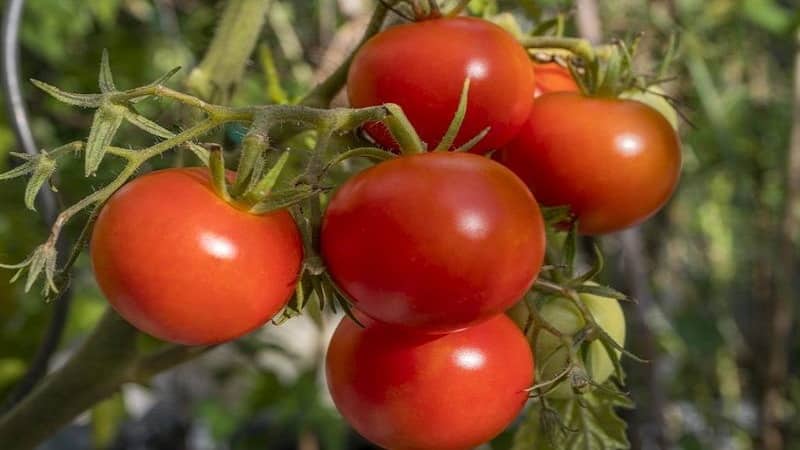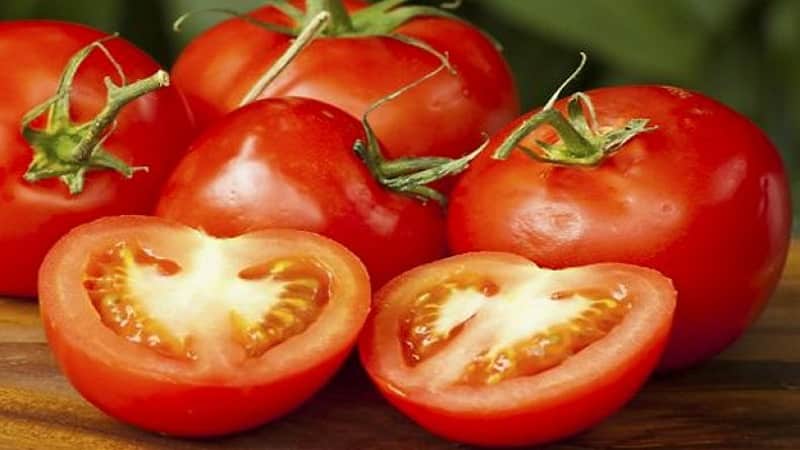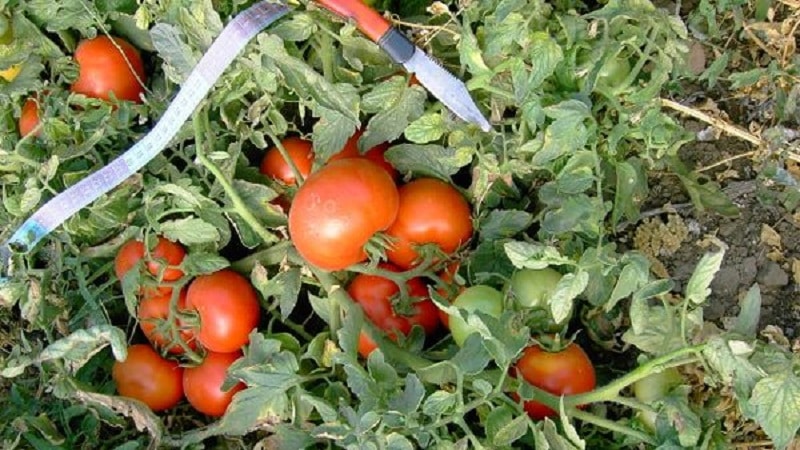An early rich harvest to the delight of every summer resident - Polbig tomato
The Dutch hybrid Polbig f1 pleases gardeners with its high productivity, undemandingness to soil composition and growing conditions. Thanks to early ripening and strong immunity, the crop does not have time to become infected with late blight and does not need preventive treatment against insect pests.
In this article we will talk in detail about the characteristics of the hybrid and the features of growing in protected and unprotected soil.
Description of the hybrid
Tomato Polbig f1 is a hybrid bred by breeders of the Dutch company Bejo Zaden. Included in the State Register of Russia in 2005. Specially created for cultivation in open ground. Bushes determinant.
Ovaries are formed even in low temperature conditions. The stems are thick, the rhizome is powerful. The brushes require garters to supports during the season of mass fruit ripening. The plant produces almost no empty flowers.
The photo shows Polbig f1.

Distinctive features
The table summarizes the main characteristics of the hybrid:
| Indicators | Characteristic |
| Fruit weight | 100–150 g in open ground, 200 g in greenhouses |
| Form | Flat-round, medium ribbed |
| Coloring | Scarlet, with a pink tint, without a green spot near the stalk |
| Leaves | Large size from light green to green colors |
| Type of inflorescences | Simple |
| Number of slots | Four or more |
| Pulp | Dense and juicy |
| Taste | Sweet and sour |
| Skin | Dense, crack resistant |
| Purpose | For fresh consumption and preservation |
| Bush height | 60–80 cm in the garden, 1.3 m in the greenhouse |
| Ripening period | 90–95 days after germination |
| Productivity | 5–7 kg/m² |
| Sustainability | To verticillium and fusarium |
| Transportability | High |
Growing seedlings
Sowing of seedlings is carried out in the last ten days of March - the first ten days of April. Caring for seedlings is standard and includes watering and picking into separate containers.
Soil preparation and sowing
Treatment of hybrid seeds is not required: the manufacturer has already carried out all the procedures. If desired, use growth stimulants.
The soil for seedlings is prepared from a mixture of chernozem and peat in equal proportions and disinfected in the oven, microwave, or filled with a strong solution of potassium permanganate.
Boxes for future seedlings are filled with moist soil and seeds are placed in them to a depth of 1.5 cm. A layer of soil is poured on top and watered. Glass is placed on the containers or polyethylene is stretched to create a greenhouse effect. The seeds are glued at a temperature of +26 °C after 4-5 days.
Seedling care
As soon as the first shoots appear from under the ground, the film or glass is removed and the boxes are placed in a well-lit place. Water 2 times a week, avoiding overwatering.
At the stage of 2-3 true leaves, the seedlings are planted in peat or plastic pots. The seedlings do not need special feeding. Instead of watering with regular water, use an infusion on eggshells (once a week). To prepare it, put the shells (optional) in a jar (3 l) and fill it with water. Insist for a week. The product improves the growth of seedlings and their metabolism.
2-3 weeks before transferring to the ground, the seedlings are taken out into fresh air for hardening. This way the seedlings acclimatize faster in a new place.Starting with 1 hour of stay on the street, the time is gradually increased to 9-10 hours.
Agricultural technology of tomatoes

Hybrid Polbig does not require special care and can withstand cold and heat. The best place for growing tomatoes is an area where white cabbage, cauliflower, zucchini, carrots, onions, and parsley previously grew.
Landing
After 50–55 days from the moment of emergence, the seedlings are ready for planting in the ground. It is moved to the greenhouse a week earlier compared to the garden.
The planting area should be in a well-lit place. The holes are dug to a depth of 20 cm, filled with a hot solution of potassium permanganate and a handful of wood ash or 3 g of superphosphate is added.
The distance between bushes is 40 cm, between rows is 50 cm. 7–9 plants are planted per 1 m². After 4-5 days, the bushes are tied to stakes in the garden and high supports in the greenhouse.
Watering and loosening
The bushes are watered moderately at the roots, as the top layer of soil dries. Use warm, settled or rainwater. The soil is then loosened.
To reduce the frequency of weeding and stop the growth of weeds, the ground is mulched with hay, sawdust, and pine needles.
Important! Overwatering threatens to rot the root system.
Pinching and shaping the bush

In open ground, plants are planted until the first fertile cluster appears. In the greenhouse, tomatoes are formed into 2-3 stems. The shoots are broken off by hand or cut with a knife with a sharp blade.
Top dressing
Farmers note that at first the hybrid does not stand out in size, so it gives the impression of a developmental delay. However, proper care and application fertilizers help the culture gain strength.
To accelerate plant growth and the formation of ovaries, the preparations “Ovary”, “Rastvorin”, “Kemira” are used.
Nitrogen and potassium-phosphorus compositions are used as fertilizers:
- 14 days after planting the seedlings, add 20 chicken manure and 40 g of nitrophoska to 1 liter of water. The solution is diluted with water to a volume of 10 liters.
- 10 days after applying the first portion of fertilizers, dissolve 10 g of superphosphate and 20 g of chicken manure in 1 liter of water. The volume is adjusted to 10 liters. For 1 m² use 5 liters.
- 14 days after the second feeding, 20 g of superphosphate and 40 g of wood ash are dissolved in 10 liters of water. For 1 m² use 5 liters.
Important! Caring for tomatoes is not particularly difficult. The formation of ovaries occurs even in low temperature conditions.
Diseases and pests
The hybrid is resistant to fungal and bacterial infections. It has immunity at the genetic level to viral diseases - verticillium and fusarium.
Thanks to early ripening, the crop does not have time to become infected with late blight and is not susceptible to attacks by most insects. Therefore, plants do not need preventive treatments with fungicides.
The nuances of growing in open ground and greenhouses
When planting seedlings in open ground in early May, a protective film is used due to the threat of night frosts.
To obtain a rich harvest in a greenhouse, the bushes are formed into 2 stems and tied to supports. Farmers note that under such conditions the taste of the fruit deteriorates slightly. This is due to the specific characteristics of the hybrid, which shows the best results in open ground.
Harvesting and application
The first harvest is harvested 90–95 days after emergence. Early fruits are used for preparing salads and vegetable slices. The second wave of the harvest is processed into tomato juice, paste, adjika, preserved in pieces. Fruiting continues until the end of August.
Advantages and disadvantages
Advantages of a hybrid:
- early and friendly ripening of fruits;
- long shelf life (up to 3 weeks);
- resistance to viral and bacterial diseases;
- powerful rhizome;
- resistance to adverse weather conditions;
- uniform color;
- same size of tomatoes;
- dense skin, not prone to cracking.
Disadvantage - necessity stepsons, formations and garters bushes
Reviews
There are both positive and negative reviews about the Polbig hybrid:
Varvara, Korostyn: “I grow tomatoes in a greenhouse for sale. Hybrid Polbig is among my favorites due to its ease of care, undemanding soil composition and high productivity. These are one of the first tomatoes to appear on sale. The taste is sweet and sour, the flesh is fleshy and juicy.”
Leonid, Berdsk: “I recommend Polbig tomatoes for growing to anyone looking for unpretentious early hybrids. Caring for the bushes is simple: just water it moderately and feed it with complex mineral fertilizers. The culture is resistant to diseases, including late blight.”
Anna, Stary Oskol: “Last year I tried to grow these tomatoes in the garden. The characteristics and description on the packaging are true. There were no difficulties with them; I planted the bushes in mid-May. Fruiting is abundant and friendly. But I was not pleased with the taste of tomatoes. There is no usual aroma, the flesh is sour. I used it for preservation for the winter.”
Conclusion
Hybrid Polbig f1 is suitable for those who grow tomatoes for sale. The fruits ripen early (only 90–95 days after germination), retain their presentation for up to 3 weeks, and tolerate transportation well.
The culture is unpretentious in care, does not suffer from bacterial and viral diseases, and does not require repeated feedings. Tomatoes have a good taste, but do not have a pronounced “tomato” aroma.